If you’ve ever asked yourself, “What happened to my cake?” after a baking flop, I’ve got tons of baking tips here for common cake baking problems, why they happen and how to prevent them.
With these tips, you can stop having baking flops and start baking amazing cakes every single time.
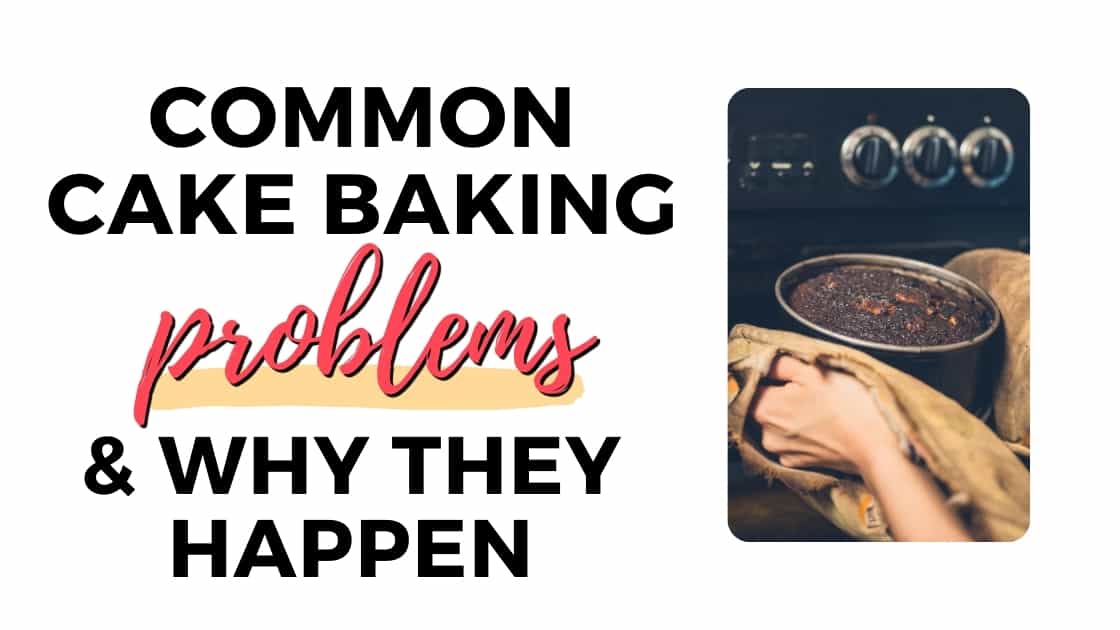
Would you like to save this?
If cake baking problems and fails are constantly getting you down, you’ll get some helpful cake troubleshooting tips in this post plus easy ways to keep those cake baking fails from happening in the first place.
Here’s the thing though, ANY cake baking problem could have a multitude of reasons for why it’s happened. For simplicity’s sake, I’m going to just talk about common problems.
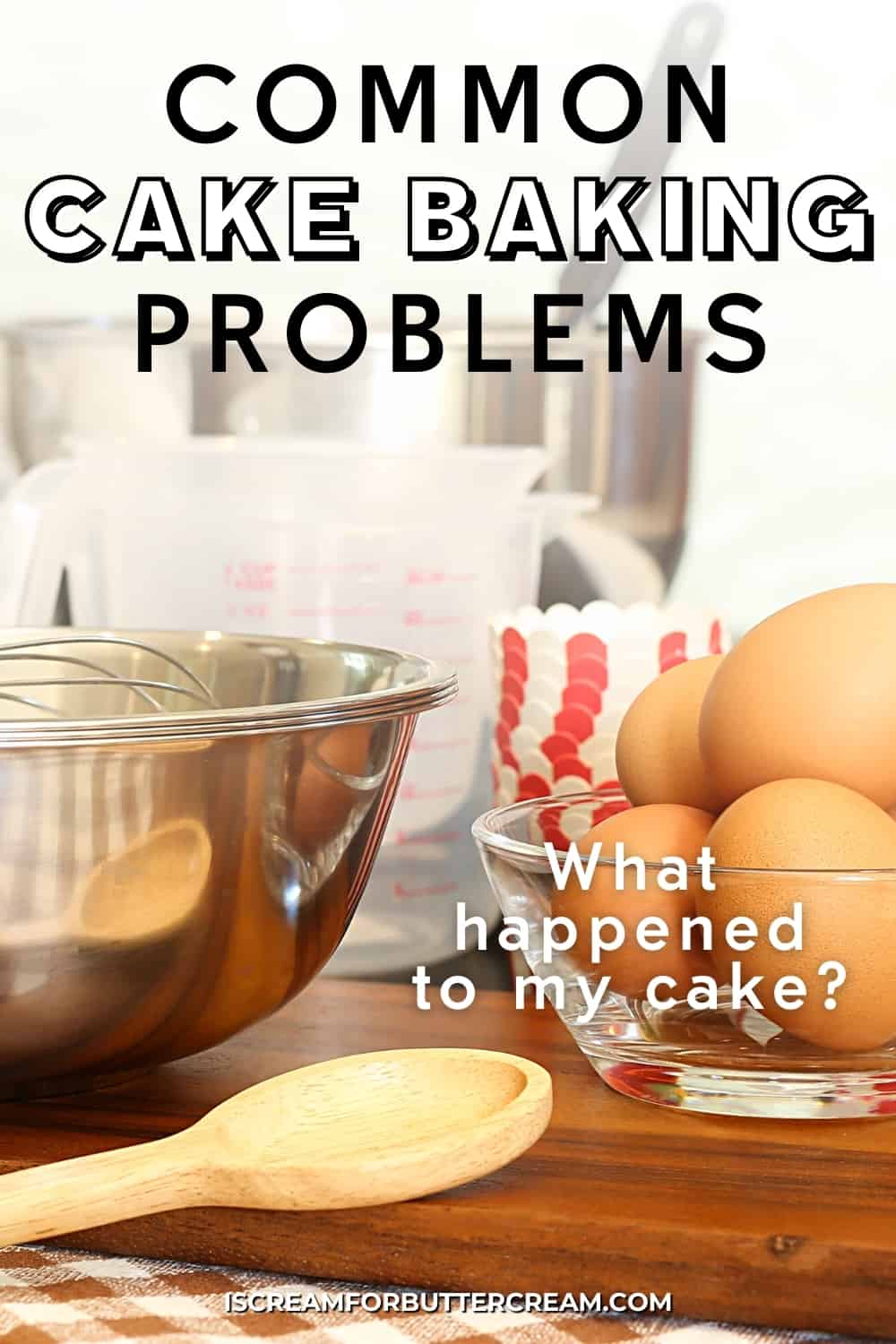
Jump to:
- Cake Problem & Reason Table:
- Problem #1: The cake is dry
- Problem #2: The cake is wet on the bottom
- Problem #3: The cake sunk in the middle
- Problem #4: The cake is done or over-baked on the outside, but not done in the middle
- Problem #5: The cake stuck to the pan
- Problem #6: The cake has glue-like streaks in it
- Problem #7: There are holes in the cake
- Problem #8: The cake is too dense
- Problem #9: The cake didn’t rise
- Problem #10: The cake is tough
- Problem #11: The cake is cracked on the top
- Main cake baking tips to remember:
- Favorite cake recipes to try out:
Below is a quick summary of the issues that could come up when baking cakes and what could have caused them.
Note that there could be multiple reasons for things happening to your cakes. It could be one of these things, or several at the same time. This list is just a good starting point and we’ll get to more details below.
Cake Problem & Reason Table:
| Cake Baking Problem | What Could Have Happened |
|---|---|
| The cake is dry | Baked too long, too much flour & not enough moisture, baked at a lower temp for too long, problems with the recipe. |
| The cake is wet on the bottom | Too much liquid was added. |
| The cake sunk in the middle | Opened the oven door too much or slammed it closed, too much leavening added, oven temp too high or even too low, under-baked. |
| The cake is done on the outside, but not in the middle | Oven temp could be too high. |
| The cake stuck to the pan | The pan wasn’t prepared correctly before the batter was added. |
| The cake has glue-like streaks in it | Mixing the batter at too high of speed, or just mixing it for too long. |
| Holes in the cake | Mixing the batter at too high of speed, or mixing it too long. |
| The cake is dense | Over-mixing the batter, not measuring flour and other dry ingredients correctly, oven was too cool, the type of recipe. |
| The cake didn’t rise | Insufficient leavening ingredients or forgot to add it in, baking powder out of date, oven temp was too low, cake batter wasn’t baked immediately. |
| The cake is tough | Mixing the batter for too long, too much flour added. |
| The cake cracked on top | Too much leavening ingredient added, heat is too high, not really a major problem. |
| *A quick word about substitutions | Be very careful about substituting ingredients. I don’t recommend it, but it can be done for certain ingredients. Cake baking is very precise and subbing out one ingredient, or lowering amounts could have detrimental effects on the final outcome. |
I wish I could just say, oh the problem is XYZ, but in the cake baking world it just isn’t like that…there can be several different reasons.
Now let’s take a look at each baking problem and talk about what could have happened.
(These are in no particular order.)
As an Amazon Associate, I earn from qualifying purchases.
Problem #1: The cake is dry

This is the biggest insult I think bakers could get. Sometimes it seems like you you try to do everything right and it still turns out dry.
What could have happened:
Baked too long:
It’s easy to over-bake cakes…especially vanilla cakes, which tend to dry out in the oven even quicker.
Test your cake for doneness before the time is up. Use the toothpick trick, but with a variation. Instead of waiting until it comes out clean, go ahead and pull the cake out when there are still a few moist crumbs on the toothpick.
Waiting until the toothpick comes out absolutely clean will sometimes over-bake the cake.
I have an entire post all about how to tell when a cake is done baking. Go here to see that post: How to Tell When a Cake is Done
Too much flour or not enough moisture in the recipe:
It’s possible that the ingredients were measured wrong. That happens to the best of us…I promise.
Sometimes we don’t even know that we’re measuring wrong. For example, if you’re taking your measuring cup and scooping out the flour, then that’s actually packing the flour into your cup and you’ll add too much to your cake batter.
You want to spoon your flour into the measuring cup and level it off to get the proper amount.
I do go through exactly how to measure ingredients in this post. There’s even a video as well.
It’s also possible to forget to add in the liquid ingredients, or perhaps there’s a mistake on the recipe.
Baked at a lower temp for too long:
If the temperature is too low, then it will take a long time to bake, which could cause it to dry out.
Now, you don’t want to amp up the temperature to make it bake faster, because then you could get into another problem and it could be over-done on the outside and not baked in the middle. (We’ll get to that in a bit.)
Just check your oven temp with an oven thermometer to see if it’s accurate and set your temp for what the recipe states.
It could just be the recipe:
If you’ve used a recipe multiple times and you know that you didn’t make any mistakes or used any substitutions, well it could just be the recipe and you may need to try another one.
If you want more tips on how to get moist cakes, check out this post: How to Get Moist Cakes
Problem #2: The cake is wet on the bottom

Has this ever happened to you? The bottom of the cake just seems soggy. A soggy-bottom cake is never a good thing.
What could have happened:
Too much liquid in the recipe:
It’s possible that either the recipe called for too much liquid, or the liquid was measured incorrectly.
Problem #3: The cake sunk in the middle

Ever have a cake fall when you just checked it for doneness in the oven? Or maybe it looked perfect, but once you pulled it out of the oven, it just completely collapsed on itself? That’s just the worst.
What could have happened:
Opened the oven door too much, or slammed it closed:
There is a fine line when it comes to checking on a cake while it’s baking. You really want to keep that oven door closed up until you think the cake is done.
Opening and closing the oven door will affect the temperature and cause big variations. And whatever you do, don’t let the oven door slam shut.
If you jostle the cake at all, then the tiny bubbles that were made during the mixing and baking process will pop and your cake could collapse.
When you test the cake for doneness, don’t pull the cake all the way out of the oven to do that. Leave it there…you want to move it the least amount possible.
Too much leavening was added, so the cake rose up too quickly, then fell:
If you (either by accident, or were told to in a recipe) added too much leavening to your cake batter, then it could have risen up really quickly and way too high and then just quickly fell.
Oven temp could be too high or low…either one:
Like I mentioned above, oven temp variations are never good and when it’s either way too cool or way too hot, it can really mess with how your cake is rising, or if it ever rises to begin with.
A cake needs heat to help it rise (if you’re using things like baking powder and baking soda) and if the temp is too low, well it just won’t get enough of a boost to help it rise.
It was under-baked…pulled out of the oven too soon when the middle wasn’t baked yet:
In our quest to get moist cakes, sometimes we just pull the cake out a little too soon. If it’s not fully baked in the middle, then once you pull it out of the oven, it will just collapse on you.
As I talked about above, you can use the toothpick method to check for doneness, but you can go ahead and pull the cake out when it has a few moist crumbs on the toothpick…just don’t pull the cake out of the oven yet if there is still raw batter on the toothpick.
For more tips on what you definitely don’t want to do when baking cakes, check out this post: The Biggest Cake Mistakes You Don’t Want to Make
Problem #4: The cake is done or over-baked on the outside, but not done in the middle
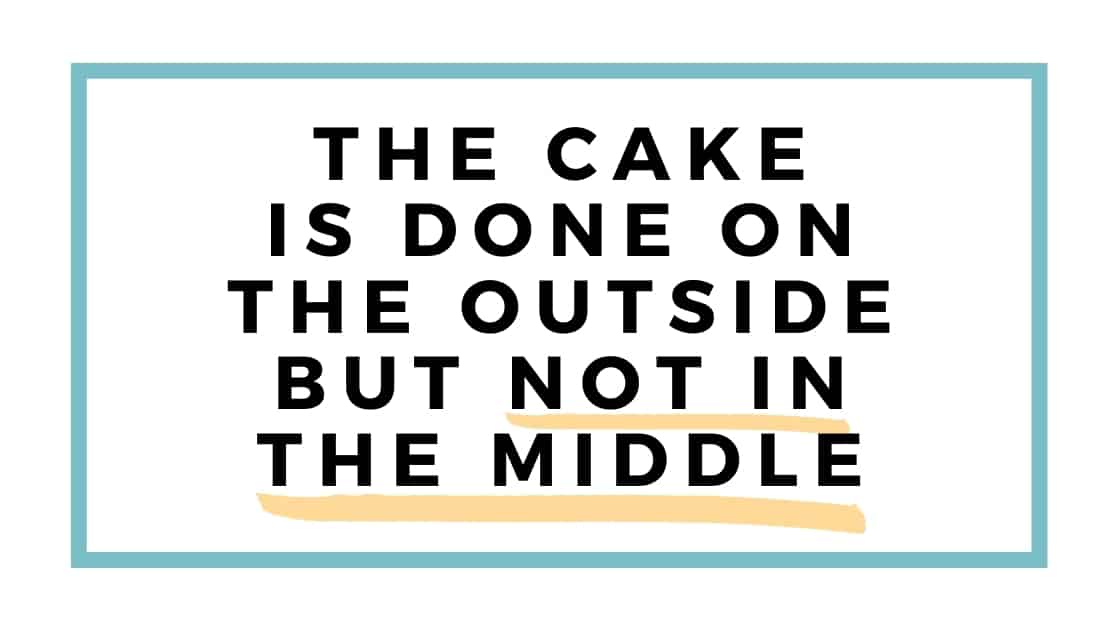
This one is frustrating because it can actually look really good…at least for a little while.
What could have happened:
Oven temp is too high, so the outside baked before the middle had a chance to:
Make sure you’ve set your oven temp. to the correct temperature.
If this is consistently happening to you, then you may need to get an oven thermometer because your oven could be off.
Problem #5: The cake stuck to the pan
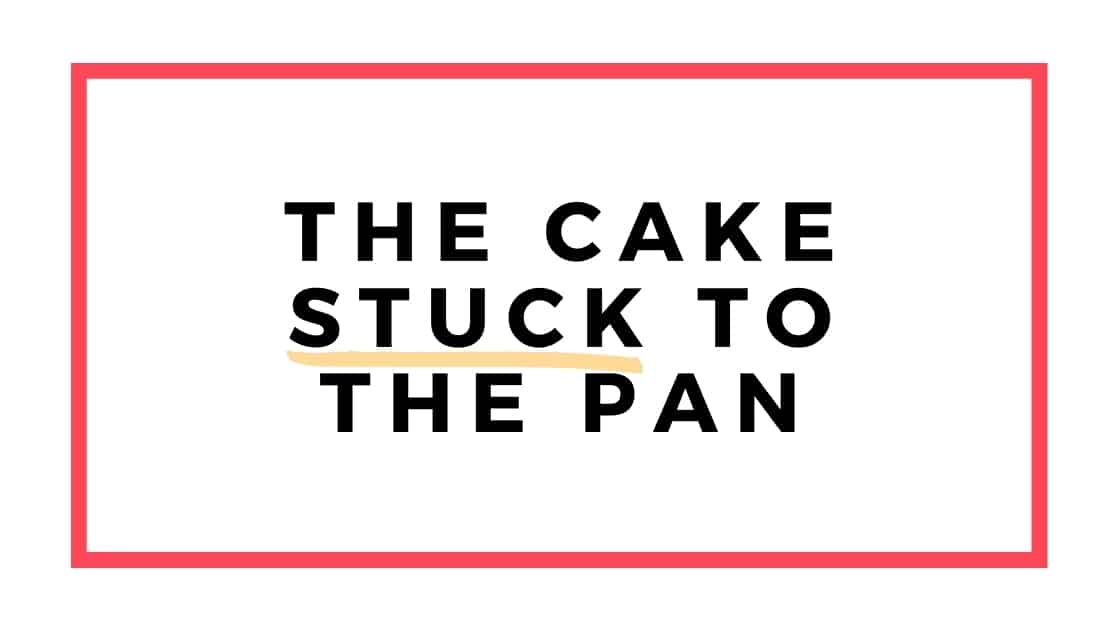
This one is fairly simple to prevent.
What could have happened:
The cake pan wasn’t prepared correctly:
It’s really important to prepare your pans correctly. You definitely want to follow the recipe instructions, but I always try to err on the side of going overboard, but that’s just me.
Lot’s of people use parchment paper to line their pans, but you can also use shortening and flour, baking spray and the pan release recipe.
I’ve got a post that really goes into the details on how to do that and it will prevent your cakes from sticking to their pans. You can see that post here: Tips for Getting Your Cakes to Release from Their Pans
Problem #6: The cake has glue-like streaks in it

This problem is so frustrating. The cake will look good from the outside, but when you cut into it, it has these rubbery glue-ish streaks throughout it. Even the bottom may be rubbery the whole way through.
What could have happened:
Over-mixing the batter or even creaming the sugar and butter at high speed:
Generally just over-mixing batter (mixing it at too high of speed), or mixing it for too long will cause this.
It’s essentially gluten overdevelopment and it’s real easy to do. My best advice is that when mixing up scratch cakes, you just want to be very careful to only mix until everything is well combined, then stop.
You can cream the butter and sugar for several minutes…if you’re using the creaming method, that’s what you want to do to incorporate air, but once you start adding liquids into the cake, then go easy on the mixing.
Mixing at high speed could cause the cake to have these gluey-like, rubbery streaks through it.
I have a post and video on how to mix cake batter and it shows, in real time, how long to actually mix it. You can see that post here.
Problem #7: There are holes in the cake

These could be large air pockets or just little tunnels that you see running throughout your cake.
What could have happened:
Over mixing the batter or just mixing at too high a speed:
This is essentially the same problem as we just discussed. Mixing too much and at too high a speed can really wreck a cake.
Try to mix on medium and to stop after the ingredients are well combined.
Problem #8: The cake is too dense

Ok, so scratch cakes can sometimes be a little more dense than cake mix cakes…depending on the type of scratch cakes.
But if your cake is way over the top dense, then something is definitely wrong.
What could have happened:
Over-mixed the batter:
Oh yes, I’m falling back on this one again. It really does cause a lot of problems though.
The biggest problem I see in scratch cake baking are dense cakes and it’s mostly caused by over-mixing (mixing too long or at too high of speed).
Make sure to measure the flour correctly-don’t pack it down when measuring:
If the dry ingredients are measured incorrectly, then that could cause this. Make sure when measuring flour, that you don’t pack it into the measuring cup.
Don’t use that measuring cup to dip out the flour…you’ll end up with too much flour. Spoon the flour into the measuring cup and level the top off. Your cakes will end up more moist and much lighter.
Oven was too cool:
If the oven is too cool then it will bake the cake too slowly and it won’t rise properly…everything will be a little compacted down.
Problem #9: The cake didn’t rise
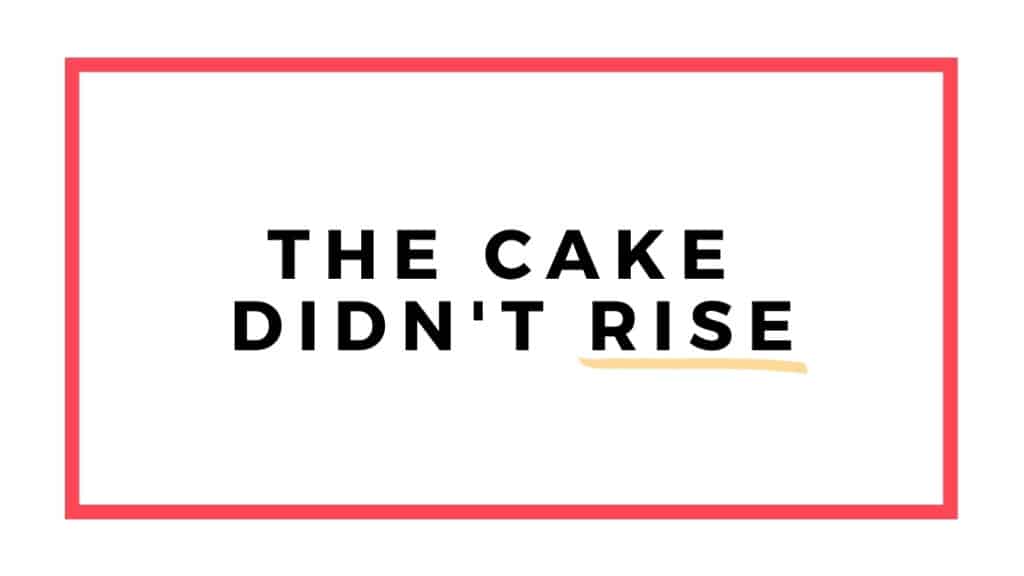
Nothing can be as frustrating as taking the time and ingredients to mix up a cake and then it’s totally wasted because it doesn’t rise.
What could have happened:
Insufficient leavening was added, or forgot to add it in completely:
If you measured the baking powder or soda incorrectly, or just left it completely out by mistake, then this can happen. Seriously, it’s happened to the best of us.
Baking powder or soda is old:
Make sure to check your baking soda or baking powder…they will go out of date. I like to replace mine at least every six months, so they don’t lose potency.
Also, you definitely don’t want to substitute one for the other. If you want more info on that subject, you’ll want to check out this post: What’s the Difference Between Baking Soda and Baking Powder When Baking Cakes?
Oven temp was too low:
If you’re sure you set the oven temp correctly, you may want to get an oven thermometer to make sure your oven is accurate.
The cake batter wasn’t baked immediately:
If you mix up the cake batter, chill it and bake it later, there’s no guarantee it’ll rise properly, especially if you’ve used baking soda in the cake recipe.
I go into all those details in this post: How Long Does Cake Batter Last?
Problem #10: The cake is tough

This can be similar to a dense cake, but it’s to a whole other level.
What could have happened:
Over-mixing the batter:
You knew I would say this, right? Over-mixing cake batter is the biggest reason your cake could have ended up tough. It likely means the gluten was over-developed.
In general, once the liquid is added to the dry ingredients, you want to only mix until everything is well incorporated…much different than if you were mixing up a cake box mix.
Too much flour:
Make super sure that you’re not packing down the flour when you’re measuring it. Spoon the flour into the measuring cup and level it off to measure.
Problem #11: The cake is cracked on the top

A lot of people don’t like the look of this, but it’s easy to take care of. You can always just slice off the top of the cake and level it off. If it really bother you though, there are a couple things it could be.
What could have happened:
Too much leavening was added:
If you added too much baking soda or powder (or if the recipe called for too much), then it could cause it to rise too high.
Heat is too high:
Having the temperature too high could also cause the cake to rise really high up and for the cake to crack.
Not really a big problem:
Sometimes this just happens and it doesn’t really mean anything is wrong.
A lot of times, these cakes are fine to eat, you’ll just want to trim the dome off the top, if there’s one.
Problem #12: The cake has gone missing (Okay bad joke…I just had to do it)

What could have happened:
Check the husband, wife, kids…but it’s probably too late. Never admit it, if it was you. ?
Main cake baking tips to remember:

- Check the oven temperature and make sure to preheat the oven.
- Don’t open and close the oven door constantly.
- Try to get ingredients as close to the same temperature before mixing up your cake batter.
- Measure properly (ie. don’t pack down your flour when measuring…you can even weigh ingredients if you want to get technical about it.)
- Follow the recipe exactly without trying substitutions right off the bat.
- Be careful not to over-mix.
- Sometimes it’s just the recipe. If you’ve tried a recipe a couple times already and it keeps coming out all wrong, you may need to look for another recipe.
If you want even more cake baking tips, you’ll want to check out all my posts for baking tips here: Baking Tips
Favorite cake recipes to try out:
Don’t forget to pin it below!
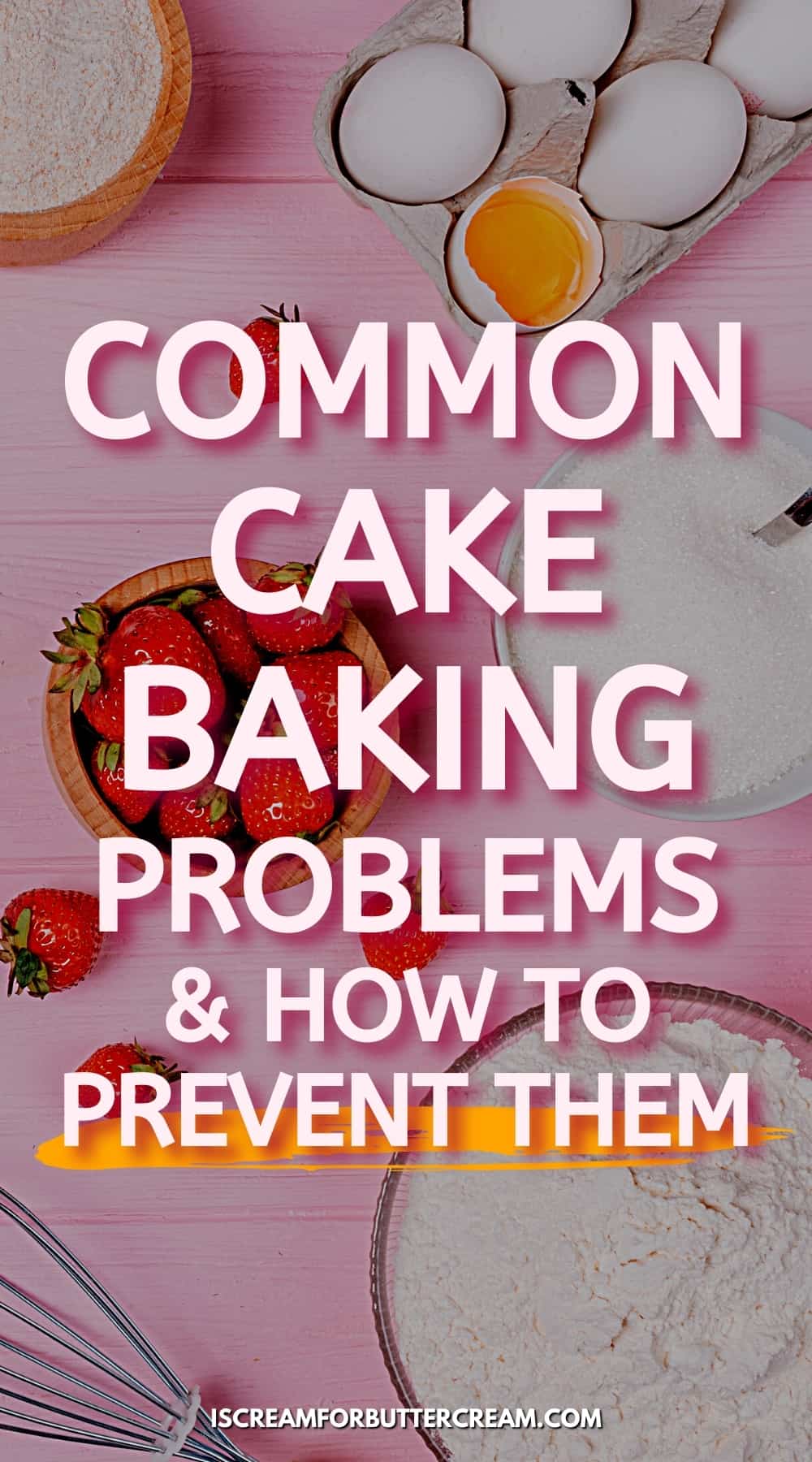
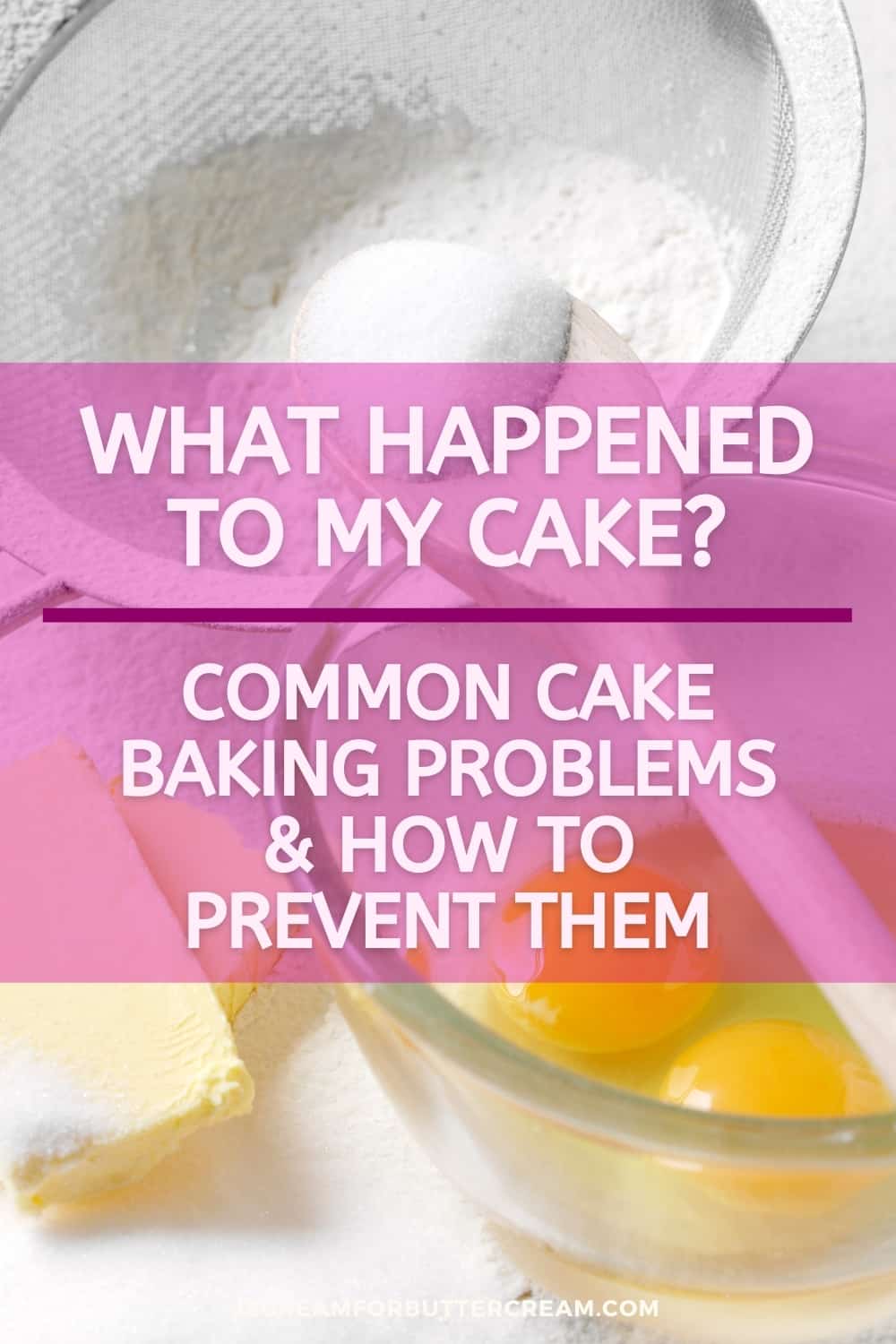

Adona
My cake is usually crumbly on the edges otherwise it’s perfect. These crumbly edges make it very difficult to put a crumb coating on none-the-less frost it. What causes this?
Kara Jane
It could be the temperature it’s baked at. You could possibly lower it a bit…maybe 15-20 degrees and bake it a tad longer (depending on what temp). You could also just try baking it five minutes less and see if that helps. It could also just be the recipe…I’ve tried some recipes that are just more crumbly than others. If you really like the recipe though and want to make it work, you could pop the cake layers in the fridge for a bit before adding a crumb coat. Sometimes that helps as well as thinning the icing you use for the crumb coat a little. Hope this helps.
Kath
thanks for the “cake problem” tips. My problem is that when I take my cakes out of the oven they are fine but when they cool I find the tops are quite sticky to the touch. This does not affect the taste and I can get round this issue by covering the cakes with icing but just wondering what I’m doing wrong. If it’s cupcakes that I’m making I remove them round the baking pan very soon after they come out of the oven but with a large cake I tend to leave it until it has cooled.
Kara Jane
Hi there, I don’t think you’re doing anything wrong. Some cake recipes just do that. If I bake a cake and it’s got a sticky top like that, I just use my cake leveler and level off that top sticky part…but really it doesn’t hurt anything.
Also, when I take my cakes out of the oven, I let them sit in their pans on cooling racks for only about 10 minutes for layer cakes and 15-20 for bundt cakes. Once the 10 minutes or so is up, I turn them out of the pans and let the cool the rest of the way on the cooling racks. I don’t think that’ll make much difference in the sticky top, but you might try it.
To me, the sticky top, just means it’s a moist cake. 😉
Claudia Rosalie Ryan
sometimes my cakes come out with a “waist “around the middle Sometimes all the way sometimes half way, What causes this
Kara Jane
Oh that is interesting. I would do several things…because I don’t know exactly what the cause could be. Get an oven thermometer and check to make sure your oven temp is correct. I’m wondering if the temperature is fluctuating quite a bit while it’s baking. Make sure not to open and close the oven door during the baking. Also, make sure to grease and flour your pans (or use pan release) and make sure to get the sides too.
You might need to check your baking soda and baking powder as well. Maybe replace them. Like I said, I’m not exactly sure what’s causing it, but I have seen it happen before, so you’re not the only one.
I’d check those things I suggested above and if they don’t help, try a different recipe and see what happens. If the new recipe comes out the same, you might need to get new pans. Some people swear by those baking strips that go around pans. I don’t use them, but I do use Magic Line pans and they bake a really even cake layer, so that’s a thought.
Cindy
I made a new gingerbread last Christmas, and the middle was sunken looking when I took it out. Oddly, it tested done. I was using a new stove and later found out that I had to heat the oven a full 30 minutes to get it to temperature (hidden coils in bottom). Since it was the best gingerbread that I had ever tasted, I wanted to get this right. I made it again a few weeks ago–oven was up to temperature, fresh baking powder and soda, did not over mix the batter, put the cake in the oven as soon as it was mixed, and checked the cake through the door window as it baked. Again, the center never fully rose. It didn’t sink, it just never completely rose. So…I still have a cake that comes out with a dipped middle. I have never had a cake fail on me, and I have been around a long time! What could possibly be wrong?
Kara Jane
Hmmm, that is a mystery. It could just be the recipe you’re using. The quantity of baking soda or baking powder in the recipe may be off or maybe the temperature the recipe calls for is off. Also, the batter might be really thick and sometimes that causes the middle not to rise enough. Without seeing the recipe, it’s hard to tell, but if you’ve done everything right on your end (and your oven bakes everything else correctly), but it’s still going wrong, then it might just be the recipe. I don’t like to blame the recipe, because we all make mistakes when following them, but sometimes the recipe might just need a little tweaking.
Mine
Hello.. Really love your recipes..pls wat is the equivalent of one cup of flour, one cup of sugar and one stick of real butter in grams..thanks
Kara Jane
Hi there. In any of my recipes, there is a button in the recipe card that you can click (it’ll say metric on it) and it will convert the measurements for you. There’s also a helpful website that can give you general conversion numbers. I’ll link that here: http://dish.allrecipes.com/cup-to-gram-conversions/
Hope this helps!
ELAINE HADAWAY
I have made German Chocolate cake for many, many years. I sometimes have spots in the cake that seem to sink, just in a couple of areas on the cake. What causes this?
Kara Jane
Hmmm that could be air bubbles in your cake, which could be caused by mixing it at too high of a speed. Sunken spots could also be caused by over mixing the batter. If it’s a scratch cake, you just want to make sure that it’s only mixed until well combined. I’m not sure why else it would happen though. That’s a mystery.
Amirah
Hi I have add 7 batches of chocolate cupcakes and I don’t think I am over mixing but the cupcakes have shiny streaks just at the bottom kind of looks like the cupcake cases indented throughout the cupcake! I have no idea what to do and I really feel like I am not overmixing!! My oven temperature has been fluctuating so not sure if it is that? Any advice will be helpful 🙂
Kara Jane
Hi there, that is interesting. Do the streaks look kind of rubbery or gummy? If so, that’s from mixing too long. If it’s the cupcake wrappers kind of wrinkling up on you, you might try a different brand and see if that has an effect. I’m not sure what the recipes calls for either, so it’s hard to say what might be happening with it. If you want to send me a picture of the streaked cupcakes, I might get a better idea of what could be happening. You can do that by sending me an email at kara@iscreamforbuttercream.com
Denyse Husbands
hi. Good day..I have a problem making sponge cakes. No matter how I try it always comes out with a sink in the middle. The outside of the cake is spongy but the middle just drops and it looks awful.. Can you advise me on this please?
Kara
Hi Denyse, I’m not an expert on sponge cakes, but what I’ve learned from baking a lot is that if the cake batter is mixed too long once the dry and liquid ingredients have been mixed together, then it will sink in the middle. It will also sink in the middle if it’s pulled out of the oven before the middle has baked fully. I have a post that talks about sinking cakes. Sponge cakes are a little different than the ones I usually bake, but perhaps that post can give you some insight. Here’s the link: https://iscreamforbuttercream.com/why-do-cakes-sink-in-the-middle/